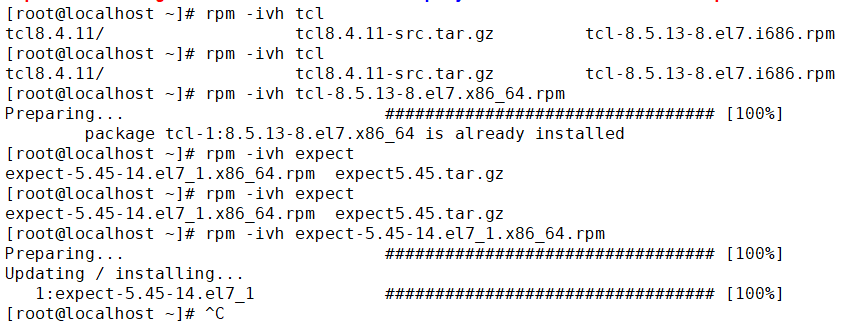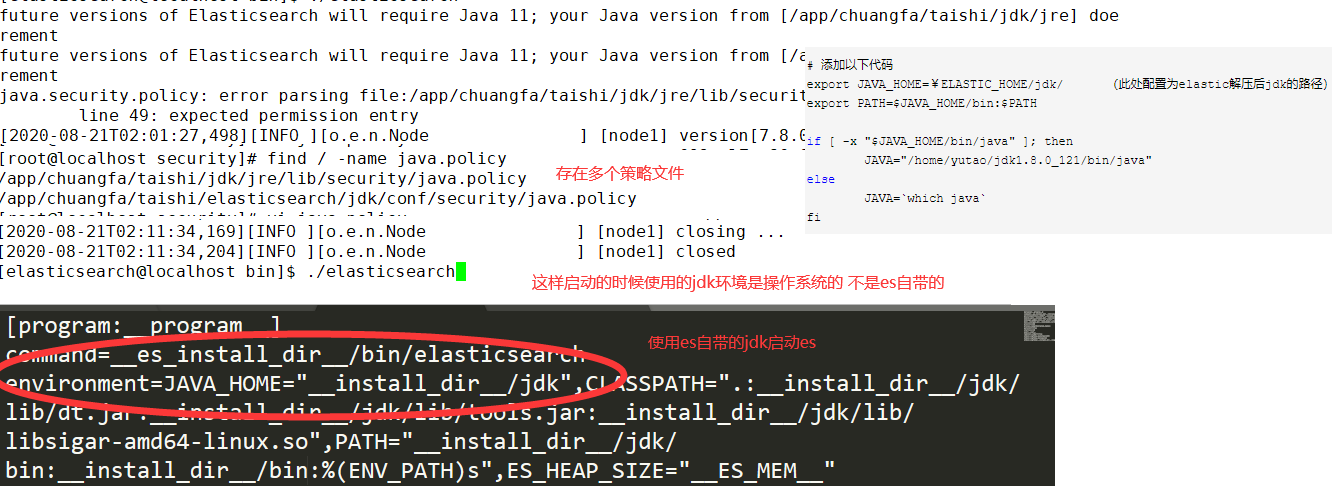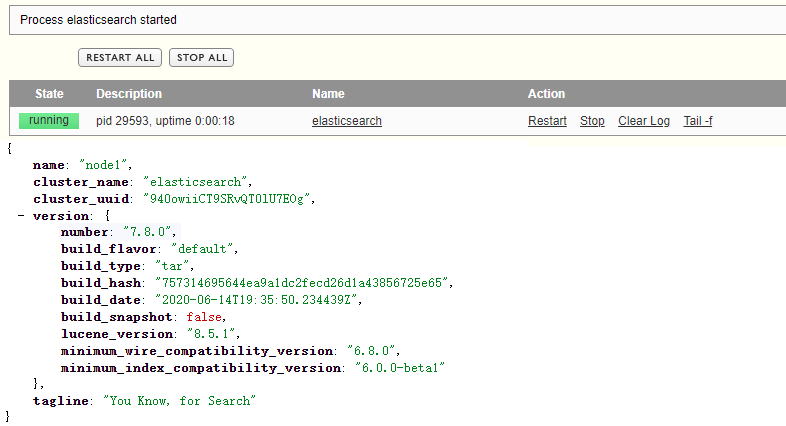生成和配置ES的安全证书
系统工具安装
1.下载离线的rpm包
yum -y install yum-utils
yumdownloader expect 把rpm包下载到本地
yumdownloader tcl


2.下载源码包需要首先编译安装 如果没有gcc的话就会编译失败.如果是下载的rpm包则不会出现依赖问题

3.rpm包自动包含了软件包所有的依赖的其它包
启动ES设置读取证书文件权限


使用不同的jdk需要设置到对应的策略文件
自动创建证书

function create_certs() { expect <<EOF spawn ${ES_INSTALL_DIR}/bin/elasticsearch-certutil cert --ip ${IP} --pem expect { #"Please enter the desired output file [certificate-bundle.zip]" { send "\n"} "Please enter the desired output file" { send "\n"} } expect eof EOF echo "证书生成完毕${ES_INSTALL_DIR}/certificate-bundle.zip" rm -fr ${ES_INSTALL_DIR}/ca rm -fr ${ES_INSTALL_DIR}/instance unzip ${ES_INSTALL_DIR}/certificate-bundle.zip -d ${ES_INSTALL_DIR} #unzip ${ES_INSTALL_DIR}/certificate-bundle.zip chown -R ${ES_USER}:${ES_USER} ${ES_INSTALL_DIR} } function modify_elastichyml() { ymlpath=${ES_INSTALL_DIR}/config cp ../../etc/elasticsearch/elasticsearch.yml ${ymlpath}/ #cp ../../etc/elasticsearch/elasticsearch.yml ${ymlpath}/elasticsearch.yml sed -i "s#__ip__#${IP}#g" ${ymlpath}/elasticsearch.yml sed -i "s#__es_install_dir__#${ES_INSTALL_DIR}#g" ${ymlpath}/elasticsearch.yml javafile=${ES_INSTALL_DIR}/jdk/conf/security/java.policy javafile2=${INSTALL_DIR}/jdk/jre/lib/security/java.policy sed -i "/permission java.util.PropertyPermission \"java.vm.name\", \"read\";/a permission java.io.FilePermission \"${ES_INSTALL_DIR}/ca/ca.crt\", \"read,write\";" ${javafile} sed -i "/permission java.util.PropertyPermission \"java.vm.name\", \"read\";/a permission java.io.FilePermission \"${ES_INSTALL_DIR}/ca\", \"read,write\";" ${javafile} sed -i "/permission java.util.PropertyPermission \"java.vm.name\", \"read\";/a permission java.io.FilePermission \"${ES_INSTALL_DIR}/instance/instance.key\", \"read,write\";" ${javafile} sed -i "/permission java.util.PropertyPermission \"java.vm.name\", \"read\";/a permission java.io.FilePermission \"${ES_INSTALL_DIR}/instance/instance.crt\", \"read,write\";" ${javafile} sed -i "/permission java.util.PropertyPermission \"java.vm.name\", \"read\";/a permission java.io.FilePermission \"${ES_INSTALL_DIR}/instance\", \"read,write\";" ${javafile} sed -i "/permission java.util.PropertyPermission \"java.vm.name\", \"read\";/a permission java.io.FilePermission \"${ES_INSTALL_DIR}/ca/ca.crt\", \"read,write\";" ${javafile2} sed -i "/permission java.util.PropertyPermission \"java.vm.name\", \"read\";/a permission java.io.FilePermission \"${ES_INSTALL_DIR}/ca\", \"read,write\";" ${javafile2} sed -i "/permission java.util.PropertyPermission \"java.vm.name\", \"read\";/a permission java.io.FilePermission \"${ES_INSTALL_DIR}/instance/instance.key\", \"read,write\";" ${javafile2} sed -i "/permission java.util.PropertyPermission \"java.vm.name\", \"read\";/a permission java.io.FilePermission \"${ES_INSTALL_DIR}/instance/instance.crt\", \"read,write\";" ${javafile2} sed -i "/permission java.util.PropertyPermission \"java.vm.name\", \"read\";/a permission java.io.FilePermission \"${ES_INSTALL_DIR}/instance\", \"read,write\";" ${javafile2} sed -i "/# End of file/i * soft nofile 65536" /etc/security/limits.conf sed -i "/# End of file/i * hard nofile 65536" /etc/security/limits.conf sysctl -w vm.max_map_count=262144 }
创建证书并自定义主机名
bin/elasticsearch-certutil cert --ip ${IP} --pem
默认证书中包含的主机名称为instance 应用连接es集群的时候只能使用https://instance:9200进行登录
bin/elasticsearch-certutil cert --ip ${IP} --pem --dns myes-instance
这样通过证书连接登录的时候可以通过https://myes-instance:9200进行验证登录
自动创建密码
创建密码的时候必须要等待es服务正常启动后才能执行 而不能在安装后立即执行


passwd=123456 expect <<EOF spawn /app/chuangfa/taishi/elasticsearch/bin/elasticsearch-setup-passwords interactive --batch --url https://192.168.19.135:9200 expect { "elastic" { send "$passwd\n";exp_continue} "elastic" { send "$passwd\n";exp_continue} "apm_system" { send "$passwd\n";exp_continue} "apm_system" { send "$passwd\n";exp_continue} "kibana_system" { send "$passwd\n";exp_continue} "kibana_system" { send "$passwd\n";exp_continue} "logstash_system" { send "$passwd\n";exp_continue} "logstash_system" { send "$passwd\n";exp_continue} "beats_system" { send "$passwd\n";exp_continue} "beats_system" { send "$passwd\n";exp_continue} "remote_monitoring_user" { send "$passwd\n";exp_continue} "remote_monitoring_user" { send "$passwd\n"} } expect eof EOF echo "密码生成完毕"

function modify_conf() { #ES supervisord启动配置 mkdir -p ${INSTALL_DIR}/etc/supervisord elasticsearch_ini=${INSTALL_DIR}/etc/supervisord/elasticsearch.ini elasticsearch_program=elasticsearch cp ../../etc/supervisord/elasticsearch.ini ${elasticsearch_ini} sed -i "s#__es_install_dir__#${ES_INSTALL_DIR}#g" ${elasticsearch_ini} sed -i "s#__install_dir__#${INSTALL_DIR}#g" ${elasticsearch_ini} sed -i "s#__program__#${elasticsearch_program}#g" ${elasticsearch_ini} if [ ${USER} == "root" ];then sed -i "s#__user__#${ES_USER}#g" ${elasticsearch_ini} chown -R ${ES_USER}:${ES_USER} ${elasticsearch_ini} else sed -i "s#__user__#${USER}#g" ${elasticsearch_ini} chown -R ${USER}:${USER} ${elasticsearch_ini} fi #es配置 mkdir -p ${INSTALL_DIR}/etc rm -f ${ES_INSTALL_DIR}/config/elasticsearch.yml # cp ../../etc/elasticsearch/elasticsearch.yml ${ES_INSTALL_DIR}/config/ # sed -i "s#__es_install_dir__#${ES_INSTALL_DIR}#g" ${ES_INSTALL_DIR}/config/elasticsearch.yml # cp ../../etc/elasticsearch/jvm.options ${ES_INSTALL_DIR}/config/ # cp ../../etc/elasticsearch/log4j2.properties ${ES_INSTALL_DIR}/config/ if [ ${USER} == "root" ];then # shell中的:号表示pass 什么也不执行 chown -R ${ES_USER}:${ES_USER} ${MODE_DIR} chown -R ${ES_USER}:${ES_USER} ${ES_INSTALL_DIR} # 直接修改目录的属主和属组即可 目录下的所有文件都可以被修改掉 #chown -R ${ES_USER}:${ES_USER} ${ES_INSTALL_DIR}/config/elasticsearch.yml #chown -R ${ES_USER}:${ES_USER} ${ES_INSTALL_DIR}/config/jvm.options #chown -R ${ES_USER}:${ES_USER} ${ES_INSTALL_DIR}/config/log4j2.properties else : fi } function Install() { #获取ES安装包 getPackage=`ls -l ../../src/ | grep "elasticsearch-[0-9]" | awk '{print $9}'` echo "Obtain elasticsearch installation package ${getPackage}" #解压es安装包 tar zxvf ../../src/${getPackage} -C ../../tmp/ 2>&1 >/dev/null #获取es解压目录 getName=`ls -l ../../tmp/ | grep "elasticsearch" | awk '{print $9}'` echo "Get directory ${getName}" echo "${ES_INSTALL_DIR}" mv ../../tmp/${getName} ${ES_INSTALL_DIR} } function main() { #默认es版本呢 es_version_tmp=`ls -l ../../src/ | grep "elasticsearch-[0-9]" | awk '{print $9}' | grep -oE '[0-9]+\.[0-9\.]+'` es_version=${es_version_tmp%?} echo "es version ${es_version}" Install modify_conf create_certs modify_elastichyml create_passwd } function create_certs() { expect <<EOF spawn ${ES_INSTALL_DIR}/bin/elasticsearch-certutil cert --ip ${IP} --pem expect { #"Please enter the desired output file [certificate-bundle.zip]" { send "\n"} "Please enter the desired output file" { send "\n"} } expect eof EOF echo "证书生成完毕${ES_INSTALL_DIR}/certificate-bundle.zip" rm -fr ${ES_INSTALL_DIR}/ca rm -fr ${ES_INSTALL_DIR}/instance unzip ${ES_INSTALL_DIR}/certificate-bundle.zip -d ${ES_INSTALL_DIR} #unzip ${ES_INSTALL_DIR}/certificate-bundle.zip chown -R ${ES_USER}:${ES_USER} ${ES_INSTALL_DIR} } function modify_elastichyml() { ymlpath=${ES_INSTALL_DIR}/config cp ../../etc/elasticsearch/elasticsearch.yml ${ymlpath}/ #cp ../../etc/elasticsearch/elasticsearch.yml ${ymlpath}/elasticsearch.yml sed -i "s#__ip__#${IP}#g" ${ymlpath}/elasticsearch.yml sed -i "s#__es_install_dir__#${ES_INSTALL_DIR}#g" ${ymlpath}/elasticsearch.yml javafile=${ES_INSTALL_DIR}/jdk/conf/security/java.policy javafile2=${INSTALL_DIR}/jdk/jre/lib/security/java.policy sed -i "/permission java.util.PropertyPermission \"java.vm.name\", \"read\";/a permission java.io.FilePermission \"${ES_INSTALL_DIR}/ca/ca.crt\", \"read,write\";" ${javafile} sed -i "/permission java.util.PropertyPermission \"java.vm.name\", \"read\";/a permission java.io.FilePermission \"${ES_INSTALL_DIR}/ca\", \"read,write\";" ${javafile} sed -i "/permission java.util.PropertyPermission \"java.vm.name\", \"read\";/a permission java.io.FilePermission \"${ES_INSTALL_DIR}/instance/instance.key\", \"read,write\";" ${javafile} sed -i "/permission java.util.PropertyPermission \"java.vm.name\", \"read\";/a permission java.io.FilePermission \"${ES_INSTALL_DIR}/instance/instance.crt\", \"read,write\";" ${javafile} sed -i "/permission java.util.PropertyPermission \"java.vm.name\", \"read\";/a permission java.io.FilePermission \"${ES_INSTALL_DIR}/instance\", \"read,write\";" ${javafile} sed -i "/permission java.util.PropertyPermission \"java.vm.name\", \"read\";/a permission java.io.FilePermission \"${ES_INSTALL_DIR}/ca/ca.crt\", \"read,write\";" ${javafile2} sed -i "/permission java.util.PropertyPermission \"java.vm.name\", \"read\";/a permission java.io.FilePermission \"${ES_INSTALL_DIR}/ca\", \"read,write\";" ${javafile2} sed -i "/permission java.util.PropertyPermission \"java.vm.name\", \"read\";/a permission java.io.FilePermission \"${ES_INSTALL_DIR}/instance/instance.key\", \"read,write\";" ${javafile2} sed -i "/permission java.util.PropertyPermission \"java.vm.name\", \"read\";/a permission java.io.FilePermission \"${ES_INSTALL_DIR}/instance/instance.crt\", \"read,write\";" ${javafile2} sed -i "/permission java.util.PropertyPermission \"java.vm.name\", \"read\";/a permission java.io.FilePermission \"${ES_INSTALL_DIR}/instance\", \"read,write\";" ${javafile2} sed -i "/# End of file/i * soft nofile 65536" /etc/security/limits.conf sed -i "/# End of file/i * hard nofile 65536" /etc/security/limits.conf sysctl -w vm.max_map_count=262144 } function setpasswd() { passwd=${ES_PASSWD} expect <<EOF spawn ${ES_INSTALL_DIR}/bin/elasticsearch-setup-passwords interactive --batch --url https://${IP}:9200 expect { "elastic" { send "$passwd\n";exp_continue} "elastic" { send "$passwd\n";exp_continue} "apm_system" { send "$passwd\n";exp_continue} "apm_system" { send "$passwd\n";exp_continue} "kibana_system" { send "$passwd\n";exp_continue} "kibana_system" { send "$passwd\n";exp_continue} "logstash_system" { send "$passwd\n";exp_continue} "logstash_system" { send "$passwd\n";exp_continue} "beats_system" { send "$passwd\n";exp_continue} "beats_system" { send "$passwd\n";exp_continue} "remote_monitoring_user" { send "$passwd\n";exp_continue} "remote_monitoring_user" { send "$passwd\n"} } expect eof EOF } function create_passwd() { su - ${ES_USER} -c ${ES_INSTALL_DIR}/bin/elasticsearch & > /dev/null 2>&1 local count=0 for((i=1;i<=5;i++)); do count=`netstat -antp | grep 9200 | wc -l` sleep 5 if [ "$count" -gt 0 ];then break fi done if [ "$count" -gt 0 ];then echo "ES success to start. set user passwd" setpasswd else echo "ES failed to start in 5 minutes." fi sleep 3 } if [ $# -eq 0 ]; then __ReadINI ../../conf/.config.ini main else __Plugin_Deployment_Before $1 main 2>&1 | tee -a ../../log/enterprise.log __Plugin_Deployment_After fi
登录ES

shell执行几点区别
su - user -c program
其中user为用户名 program为要运行的程序, 如su - isoa -c /usr/isoa/bin/gtimer.sh

第一行指定解析器的话 启动执行的需要使用./start-cluster.sh的方式 使用 sh start-cluster.sh的方式可能会出现执行失败的情况
linux ./a.sh 命令与sh a.sh的区别为:可执行属性不同、执行方式不同、兼容性不同。
一、可执行属性不同
1、 ./a.sh 命令: ./a.sh 命令的文件必须具有可执行属性
2、 sh a.sh命令:sh a.sh命令的文件不必具有可执行属性
二、执行方式不同
1、 ./a.sh 命令:./a.sh 命令使用脚本中第一行所指定的命令来解释和执行文件
2、 sh a.sh命令:sh a.sh命令使用shell工具的SH脚本直接解释和执行文件
本文来自博客园,作者:不懂123,转载请注明原文链接:https://www.cnblogs.com/yxh168/p/13539231.html



